|
|
Wednesday, January 14th, 2009 at 7:42 pm
Unless you’re now to the blog, you’ve heard us quejarse (complain) a bunch about how we’re cold all the time. As of today, though, that problem is HISTORY. Our stove is here!
After nearly 2 months in transit, it arrived at the post office while we were in the US. As we passed through Santa Eulalia on the way home Monday, we picked it up. Oh, how sweet it is. It only weighs about 40 pounds, and the design is very clever- all the parts, including a special tapered nesting chimney, fit inside the body of the stove. I am totally getting one of these for my yurt when I get back to the US.
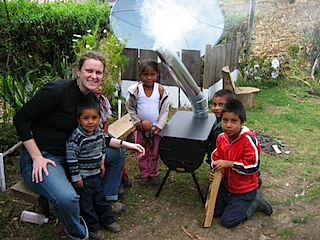 Our first job was to put it together, load it, and light it up- in the front yard. You see, the factory-applied paint has to bake on the rest of the way with the first firing, and it gives off a lot of stink that you don’t want in your house. So, here we are, enhancing our image as “weird white people that do totally inexplicable things.” Never mind that we tried to explic to everyone who wandered by; they didn’t get it. Our first job was to put it together, load it, and light it up- in the front yard. You see, the factory-applied paint has to bake on the rest of the way with the first firing, and it gives off a lot of stink that you don’t want in your house. So, here we are, enhancing our image as “weird white people that do totally inexplicable things.” Never mind that we tried to explic to everyone who wandered by; they didn’t get it.
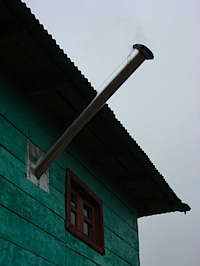 That evening was torturous to Emily, who was cold but KNEW that our stove was sitting right outside, doing us no good. So, at first light the next day, i sprang into action, breaking stuff and causing a general mess so that I could install the chimney. I cut a hole in the wall, and made a sheetmetal orifice for the stovepipe to keep the heat clear from our highly combustible, made-from-kindling wall. They only sold sheetmetal in giant coils in town, so I ended up buying a sheetmetal bucket for Q20 (about $3) and cutting it apart with aviation shears in my Peace Corps (TM) Tool Kit. Check out the rain diverter hat I made for the stovepipe, too: it’s the bottom of the bucket, cut and pulled into a cone. Then I riveted it together with some nails that I cut short, and attached clips I made from scraps of the bucket. See, grad school for metalsmithing IS applicable to third-world development work after all! That evening was torturous to Emily, who was cold but KNEW that our stove was sitting right outside, doing us no good. So, at first light the next day, i sprang into action, breaking stuff and causing a general mess so that I could install the chimney. I cut a hole in the wall, and made a sheetmetal orifice for the stovepipe to keep the heat clear from our highly combustible, made-from-kindling wall. They only sold sheetmetal in giant coils in town, so I ended up buying a sheetmetal bucket for Q20 (about $3) and cutting it apart with aviation shears in my Peace Corps (TM) Tool Kit. Check out the rain diverter hat I made for the stovepipe, too: it’s the bottom of the bucket, cut and pulled into a cone. Then I riveted it together with some nails that I cut short, and attached clips I made from scraps of the bucket. See, grad school for metalsmithing IS applicable to third-world development work after all!
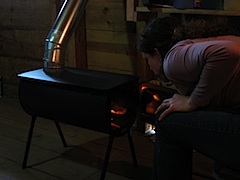 Of course, there are always hitches. This morning we opened the stove to find 1″ of water in the bottom. I guess my rain diverter wasn’t quite perfect after all. A quick trip up the ladder and a little bending set that right, however. The harder part was getting the stove started again. By the time she’d bailed it out, removed the wet coals, put new wood in, and restarted it, Emily was pretty annoyed. Luckily the stove makes coffee, too, otherwise the honeymoon would already be over. Of course, there are always hitches. This morning we opened the stove to find 1″ of water in the bottom. I guess my rain diverter wasn’t quite perfect after all. A quick trip up the ladder and a little bending set that right, however. The harder part was getting the stove started again. By the time she’d bailed it out, removed the wet coals, put new wood in, and restarted it, Emily was pretty annoyed. Luckily the stove makes coffee, too, otherwise the honeymoon would already be over.
As I type, it’s in the 40s outside and drizzling, but I am quite toasty and comfortable. We’ve already had several people over, and they’ve all concluded that it is indeed comfy in here. Getting the kids to leave is now REALLY hard. We can even dry laundry in our house now, simply by putting the clothesline in the vicinity of the stove. Before, we could expect to wear the same clothes for weeks if we got caught doing laundry at the beginning of a rainy spell.
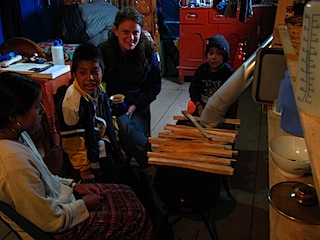 Here we are, enjoying our stove with the neighbor kids. Now all this is left is to thank Rich Tuck at The Wall Tent Shop for giving us a discount and being so helpful throughout the process. Also, we want to thank the friends that pitched in to help us. You guys rock. Here we are, enjoying our stove with the neighbor kids. Now all this is left is to thank Rich Tuck at The Wall Tent Shop for giving us a discount and being so helpful throughout the process. Also, we want to thank the friends that pitched in to help us. You guys rock.
Posted by: jfanjoy
Sunday, January 11th, 2009 at 5:49 pm

I feel like we’re finally getting to be expert travellers, especially where the Chicken Buses are concerned. What was once a HUGE amount of stress has now become almost routine. It goes kindof like this:
We walk into the bus lot, and when the ayudantes start shouting town names at us, we yell back the name of the town we want to go to. Normally, one yells it back at us and motions towards the already-rolling bus. I help Emily out of her pack (we usually have big backpacking packs on), and pass it up to the ayudante who is already on the roof. Emily hops on the bus (to snag us seats) while I pass my own pack up to the ayudante. I watch to make sure he actually ties them down, thank him, then get on the bus myself.
By the time I get on the bus, Emily has usually nabbed the safe seats for us. We met an older water system engineer during training, and he shared the secret with us: most bus accidents happen when overeager drivers are passing on two-lane roads. When they see an oncoming bus, they wait until the last second then try to swerve back into traffic, causing a nasty high-velocity head-on sideswipe. Thus, the safest seats are those towards the rear of the bus, on the passenger side. For some reason, the Guatemalans prefer to sit up front, even if it means sitting 4 to a seat, so we usually don’t have to compete for the safe seats. Sitting in the back is also nice beccause it’s a lot easier to exit when you get to your stop (since they use the emergency door as a regular door in Guatemala).
We put our knapsacks on the rack overhead, always careful that they are above and slightly in front of us (always in view, to prevent pickpocketing) and then we tie the straps around the rack (to prevent snatch-and-run). At this point, we can relax for a few minutes until the ayudante starts collecting fares. He makes his way from the front of the bus to the back, collecting money from the passengers according to their destination and some secret, unpublished fare chart in his head. This is bad news for white people, who are now subject to the Gringo Tax (being cheated). Again, Emily and I tackle the problem teamwork-style: she asks the locals sitting around us what the fare SHOULD be, while I take advantege of our rear-seat location and casually count the cash value of money changing hands as he works his way towards us. This is possible because in Guatemala, every different denomination of bill has a different color: brown= Q100, orange= Q50, blue= Q20, red= Q10, purple= Q5, and green= Q1. When he’s about a seat ahead of us, Emily and I compare notes, and if all went well, we know the real price… and pay the ayudante in exact change, before he even tells us his made-up price. Oh, and we always save up small bills before a trip, so we can make exact change.
Then, we settle in and enjoy watching the countryside roll by. If we’re tired, we sleep in shifts, to keep our eyes on our belongings.
When we finally arrive at our destination, we get our stuff and leave. For most trips, we travel the entire route of the bus (coincidence, mostly) but on occasion we have to get off the bus before the last stop. This means more teamwork: Emily warns the ayudante that we have bags on the roof, and he climbs up on to the roof while I get out and make sure all our stuff gets offloaded, and catch it as he throws it down. Sometimes, they try to leave with some of our stuff still on top (either out of carelessness or hurry), so Emily stands in the door of the bus to stop the driver if he tries to take off early.
So, now you know the many secrets of successful chicken bus travel. And let me tell you, it’s a lot harder without a partner!
Posted by: jfanjoy
Sunday, January 11th, 2009 at 5:16 pm
Our trip home was the much-needed kick in the pants that we needed for the Computer Center. I scored the following gear:
- 8 computers, keyboards, mice and a HUGE box of extra parts: network cards, hard drives, memory modules, video cards, power supplies… and the best part? All the equipment is corporate-grade, and fully interchangeable. (Mark and the folks at Wieland Furniture)
- 2 flat-panel monitors, a scanner, cables (Devin and the Hogan family)
- 3 laptops, tons of cables, 2 wifi stations, a 32-port switch, 2 huge pelican cases, and a crimping tool (The Timmons clan)
- A laptop and a desktop computer (the Fanjoy parents)
- 50 yards of ethernet cabling (US Architects)
We also received a SIZEABLE cash donation from the Trinity Episcopal Church in Logansport, Indiana. Some of that money will go towards the Computer Center project. I will be sending out thanks to all of these donors in a formal manner in the near future.
What are we still lacking? Well, about the only thing we still need is monitors. I have a potential lead on a pile of them, AND DELIVERY, but I want to keep it hushed up until i know if it will go or not (so as not to spoil the luck). And as you might imagine, delivery is the big problem for all of this… each crate costs between $150 and $300 to ship, depending on who I ask, and i have quite a few crates. But, that to may soon be solved- we’re talking right now with a Guatemalan businessman who might fund us. So, keep your fingers crossed.
Posted by: jfanjoy
Saturday, January 10th, 2009 at 8:09 pm
And by “home”, I mean Guatemala.
Here I sit in a cafe in Xela, about halfway through my homeward journey. In case we’ve not mentioned it before, the trip between Indiana and our home in Guatemala is a three-day odyssey: a day of plane travel to get to Guatemala, followed by a day and three busses to get to Xela. The last day is three more busses, taking another full day to arrive at our village.
So, what happened during the rest of our American tour? Well, the second half was mostly business: giving speeches to church, civic, and university audiences, describing our experiences and work in Guatemala. But what enjoyable work! The first group was a church group of Guatemalans that live and work in Logansport, Emily’s hometown. The group of about 200 seemed a bit unsure of what to make of us at first, but they warmed up quickly once we started talking in their own language, about people and places they knew. You see, by strange cosmic coincidence, much of the immigrant community in Emily’s hometown comes from a Guatemlan town that is so close to our village that we can see it from our window. Though their Mayan language is Chuj, and not Q’anjob’al, many words are shared between the dialects, and they were tickled to hear white people speaking ancient Mayan. We soon discovered that one of the immigrants used to live about 200 yards from our house! What a small world.
The second lecture we gave was a lunchtime presentation to about 80 businesspeople in the Logansport Rotary club. They have supported Emily before during college, and we spoke to them right before we started Peace Corps, so they already kindof knew who we were. The lecture was fun, and we ran about a half-hour over time. It is Rotary tradition to leave right at the stroke of 1:00 (to go back to work), and they did us the honor of staying the extra 30 minutes until we were finished. I guess they found us interesting!
 After the Logansport lectures, we drove to Illinois to get ready for the second lecture series. We stopped to visit our adopted grandparents, Judy & Ed Middleton, and spent a great night chatting with them. They fed us and housed us in their restored Victorian house, and when we woke up it was snowing! Yay; I was worried we’d miss snow entirely this year. After the Logansport lectures, we drove to Illinois to get ready for the second lecture series. We stopped to visit our adopted grandparents, Judy & Ed Middleton, and spent a great night chatting with them. They fed us and housed us in their restored Victorian house, and when we woke up it was snowing! Yay; I was worried we’d miss snow entirely this year.
Our third lecture was with the Spanish club at Knox College. There was apparently a misunderstanding about the time, though, and only a handful of people showed up- and we knew all of them! So, the talk was a lot of fun and really informal. Perhaps the best part of Day 3 was spending the evening with the Prado-Ragans while meeting several of Emily’s friends from college (Devin & Melanie), who traveled a long way just to see us. And I got even MORE computer stuff; Devin’s family donated an entire suitcase of stuff, including a pair of desperately needed flat-panel computer monitors.
 For our final lecture, we spoke to a general audience at Knox College. About 40 students attended, and it was a blast. They asked probing, insightful questions and the discussion was lively. Instead of our normal presentation, we focused more on the Peace Corps application and training process, and less on the specific aid projects we are working on. Afterwards, several student came up to ask us for personal advice. One girl said to Emily, “You mentioned that you’ve wanted to be in the Peace Corps since you were in high school. I am most of the way through the application process, but this is starting to look kindof scary, and I am not as sure as you are that this is what I want to do. Should I go ahead and finish the application anyways?” For our final lecture, we spoke to a general audience at Knox College. About 40 students attended, and it was a blast. They asked probing, insightful questions and the discussion was lively. Instead of our normal presentation, we focused more on the Peace Corps application and training process, and less on the specific aid projects we are working on. Afterwards, several student came up to ask us for personal advice. One girl said to Emily, “You mentioned that you’ve wanted to be in the Peace Corps since you were in high school. I am most of the way through the application process, but this is starting to look kindof scary, and I am not as sure as you are that this is what I want to do. Should I go ahead and finish the application anyways?”
“Well, it was scary for us too,” Emily replied. “But you should stick with it, until you are sure it’s not for you. You can back out at any time, and there is no penalty or anything. Do the application, and when the time to decide to go or not comes up, that is when you make the decision.”
After the lecture, my friend Mark Godsil and his wife took us out to dinner. We had a great time chatting with them about our lives, their lives, the Peace Corps, and all sorts of other stuff. Mark has been very helpful with ideas to advance our projects, and he even expressed interest in coming to Guatemala to see the work we’re doing firsthand. He and his wife have been interested in the Peace Corps for a while, and due to the demands of his business and other complications, it’s not been possible for them to participate. But he is A) a very creative, motivated person, and B) the owner of a flourishing business; so he has a lot of resources at his diposal that could really make a difference to the kind of people we serve.
 We then went back to my parents’ house, and spent most of our last day packing. This is normally a snap, as we travel light, but I had to sort, organize, and triage a MOUNTAIN of used computer gear. By the time it was done, I was sweat-soaked and dusty, but had 7 crates with a dozen computing machines and components packed up and ready to go. Now we just have to firm up one of our “maybe” donors on shipping to Guatemala, and we should be in business. I will talk more about this in a post in the near future. We then went back to my parents’ house, and spent most of our last day packing. This is normally a snap, as we travel light, but I had to sort, organize, and triage a MOUNTAIN of used computer gear. By the time it was done, I was sweat-soaked and dusty, but had 7 crates with a dozen computing machines and components packed up and ready to go. Now we just have to firm up one of our “maybe” donors on shipping to Guatemala, and we should be in business. I will talk more about this in a post in the near future.
The last few days of our USA tour, from a networking and resources standpoint, have been extremely successful. But to really explain this, I have to talk a little about Mike Richardson, Emily’s dad. Since we arrived, he’s worked tirelessly to get our names out, introduce us to interested resources, and help us set up speaking engagements. While we were travelling, he made calls to people all over the place- he got fliers printed for us, found some more donated computer equipment, found someone interested in helping us transport equipment to Guatemala, found someone with a charity organization that is assembling midwifery kits that wants to collaborate, contaced a Rotary organization that wants to donate water filters… he even found a group that wants to start a factory to build high-efficiency wood stoves with us. Mike did this all of his own accord and energy. I am just so impressed. He even hooked us up with a friend of his cousin who is a successful Guatemalan businessman. “Mario” picked us up from the airport yesterday, and drove us to Antigua in his shiny new leather-interior Volvo, and treated us to a nice meal in a restaurant owned by one of his relatives. Mario wants to help us too, and is buddies with the son of Alvaro Colom, the president of Guatemala. He speaks excellent English, and is concerned with the plight of rural Guatemalans… I will be interested to see where this leads.
And all of this was because of Mike. So, thanks Mike, on behalf of us and a lot of Guatemalans.
Posted by: jfanjoy
Sunday, January 4th, 2009 at 8:05 pm
 Well, 2009 is here, and we are enjoying flush toilets, hot showers, fireplaces, and American food. It can mean only one thing: we’re in the US! My parents gave us plane tickets as Christmas presents, so we are using up all of the vacation days we’ve accumulated so far by hanging out with family and friends (like my pal Alison, shown at the right). Oh, and we’re using a few days of vacation we DON’T have… our boss approved four extra non-vacation days in the US, to give lectures about our work in the Peace Corps. These are called “third goal” lectures, since the third goal of the Peace Corps is to bring back knowledge of foreign cultures to America and share it with our countrymen. We will be giving presentations to a church group, the Logansport Rotary club, the Spanish department at Knox College, and then a general-audience at Knox College. We have a pile of pictures arranged into a nice Powerpoint presentation, as well as data and information about Guatemala and the Peace Corps. Well, 2009 is here, and we are enjoying flush toilets, hot showers, fireplaces, and American food. It can mean only one thing: we’re in the US! My parents gave us plane tickets as Christmas presents, so we are using up all of the vacation days we’ve accumulated so far by hanging out with family and friends (like my pal Alison, shown at the right). Oh, and we’re using a few days of vacation we DON’T have… our boss approved four extra non-vacation days in the US, to give lectures about our work in the Peace Corps. These are called “third goal” lectures, since the third goal of the Peace Corps is to bring back knowledge of foreign cultures to America and share it with our countrymen. We will be giving presentations to a church group, the Logansport Rotary club, the Spanish department at Knox College, and then a general-audience at Knox College. We have a pile of pictures arranged into a nice Powerpoint presentation, as well as data and information about Guatemala and the Peace Corps.
 Even though we’re here for a little more than 2 weeks, we feel like we can’t get enough time to spend with all our friends and family. We had a christmas with Emily’s family, and New Years with mine. We even got to celebrate the last day of Hanukkah with our friends the Schneiders! Even though we’re here for a little more than 2 weeks, we feel like we can’t get enough time to spend with all our friends and family. We had a christmas with Emily’s family, and New Years with mine. We even got to celebrate the last day of Hanukkah with our friends the Schneiders!
 Last night, the Richardsons held an open house for us, and we met a lot of interesting people that wanted to hear about our work in Guatemala, and to wish us well. A Guatemalan family that escaped from the town next to us (San Sebastian Coatan) during the civil war even showed up! So, I got to check and see if I remember how to speak Spanish. Mateo, the father, even knows our friend and neighbor Nas Palas. What a small world. Last night, the Richardsons held an open house for us, and we met a lot of interesting people that wanted to hear about our work in Guatemala, and to wish us well. A Guatemalan family that escaped from the town next to us (San Sebastian Coatan) during the civil war even showed up! So, I got to check and see if I remember how to speak Spanish. Mateo, the father, even knows our friend and neighbor Nas Palas. What a small world.
 As our boss in Guatemala expected when he approved our extra leave, we’ve already had several people donate a lot of cash and supplies towards our projects. I now have 8 computers, a half-dozen laptops, a huge box of parts, networking cable, a little over $500 in cash, and news that a fair amount more is coming in the near future. Our trip wasn’t intended as a fundraising appeal, but it is turning in to that as well. I have to say, that has been one of the biggest learning experiences for me in the Peace Corps: SO MANY Americans are kindhearted people that are excited to help their fellow man, if only given an opportunity to do so. I haven’t held out my hat once, yet once people hear about what we are doing, they want to give of their time, money, and resources to help. Here’s a picture of my friends at my old job. We spent the whole day with them, showing them pictures and swapping stories. They took us out to lunch, and donated some more equipment as we left. Jerry pointed out that it’s nice to know someone who is personally doing the kind of work we do; they normally write a yearly check to United Way, but they would prefer to give to our projects while we’re in Peace Corps, because they feel more of a connection with how the money will be used. As our boss in Guatemala expected when he approved our extra leave, we’ve already had several people donate a lot of cash and supplies towards our projects. I now have 8 computers, a half-dozen laptops, a huge box of parts, networking cable, a little over $500 in cash, and news that a fair amount more is coming in the near future. Our trip wasn’t intended as a fundraising appeal, but it is turning in to that as well. I have to say, that has been one of the biggest learning experiences for me in the Peace Corps: SO MANY Americans are kindhearted people that are excited to help their fellow man, if only given an opportunity to do so. I haven’t held out my hat once, yet once people hear about what we are doing, they want to give of their time, money, and resources to help. Here’s a picture of my friends at my old job. We spent the whole day with them, showing them pictures and swapping stories. They took us out to lunch, and donated some more equipment as we left. Jerry pointed out that it’s nice to know someone who is personally doing the kind of work we do; they normally write a yearly check to United Way, but they would prefer to give to our projects while we’re in Peace Corps, because they feel more of a connection with how the money will be used.
  
My family had several days of food and fun, and many friends heard that we would be back in country, so they showed up as well from distant places like Virginia and Oregon. Dave and Kathy even brought my two new nieces, Keira and Charlotte, and we got to meet them. They are very tiny.
 Many have asked what I want for Christmas. Coming home was the only thing on the list. Oh, and also to eat a bunch of American food and to be warm. Dad seemed pretty exited about providing those things, so I have been getting all of them in spades and am quite content. It makes me think a lot about Guatemala. There is a tradition in Emily’s family, of passing a cup and sharing what you’re thankful for. I thought about it a bit, looked around the room at all the smiling family members and kids running around, and realized that what I am thankful for is this: that none of my friends and family had to be born, grow up, and live in conditions like those of Guatemala. Many have asked what I want for Christmas. Coming home was the only thing on the list. Oh, and also to eat a bunch of American food and to be warm. Dad seemed pretty exited about providing those things, so I have been getting all of them in spades and am quite content. It makes me think a lot about Guatemala. There is a tradition in Emily’s family, of passing a cup and sharing what you’re thankful for. I thought about it a bit, looked around the room at all the smiling family members and kids running around, and realized that what I am thankful for is this: that none of my friends and family had to be born, grow up, and live in conditions like those of Guatemala.
 UPDATE Feb 9,2009: My dad is of the opinion that the picture I posted is not flattering, and proposed that I send the following. The baby is Charlotte’s uncle, not Charlotte herself, but most of the other details are the same. UPDATE Feb 9,2009: My dad is of the opinion that the picture I posted is not flattering, and proposed that I send the following. The baby is Charlotte’s uncle, not Charlotte herself, but most of the other details are the same.
Posted by: jfanjoy
Thursday, December 18th, 2008 at 1:05 pm
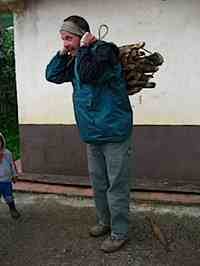 I’ve been thinking about this post for ages. The longer it takes me to actually sit down and write it, the more incidents of merit I witness. I just want to talk about Jim/Fletch/Jaime for a bit, a little behind his back. He will of course read it when it’s published, so it’s not entirely back talking, and it’s not bad. 🙂 Thing is, I was born into a family of critics. We really can’t help that we know what’s best for everybody, nor can we help letting them know. No one is more susceptible to our “wisdom” than the people we love most. That means we can sound, um, pretty critical sometimes, but I wanted to make a departure from that and heap a little praise on a guy who deserves it. So if you don’t like gushing in any form, stop reading now. I’ve been thinking about this post for ages. The longer it takes me to actually sit down and write it, the more incidents of merit I witness. I just want to talk about Jim/Fletch/Jaime for a bit, a little behind his back. He will of course read it when it’s published, so it’s not entirely back talking, and it’s not bad. 🙂 Thing is, I was born into a family of critics. We really can’t help that we know what’s best for everybody, nor can we help letting them know. No one is more susceptible to our “wisdom” than the people we love most. That means we can sound, um, pretty critical sometimes, but I wanted to make a departure from that and heap a little praise on a guy who deserves it. So if you don’t like gushing in any form, stop reading now.
Fletch doesn’t talk on the phone much, but I think every time he’s called a friend or family member he’s mentioned over and over this theory of his: he says he thinks only about 2% of Americans are meant to/have ready personalities to serve in the Peace Corp, and he says he just barely made that cut, if he’s included in that 2% at all. Maybe he’s right about the 2%. This is not always the easiest job in the world. You feel at once like you spend a ton of time doing a lot of nothing, but also like you’re ALWAYS on duty working. You have to learn a new language, or two sometimes. You have to live in a pretty adverse environment, in our case going without almost all amenities the average American sees as basic necessities–running and potable water in the house, flushing toilets, heat. We have fun with it a lot of the time, but I can see how many people would not be into this. And I have him to thank because I never would have been sent to such a cool far-out place as a single-female volunteer. I could cry “SEXISM!” to that, but the US government would shout back “SECURITY!” and they win. So Fletch-o effectively got me a kick-ass placement here in our little village. The thing that bothers me about his theory, and the reason for writing this post, is that I don’t think he’s being fair to himself. He’s been amazing.
I did lay down an ultimatum, that either I would go do Peace Corp and we’d talk about getting married later, or I could marry him when he wanted if he agreed that he’d come with me. In that sense, I think he sometimes feels like this wasn’t his idea. In fact, in his moments of supreme frustration, he closes his eyes and says, “My job here is to be Ruby’s cheerleader.” But really, who would have agreed to marry me AND come to Peace Corp if they didn’t, in some way, want this kind of adventure? We who know him well know that Jim is a guy with itchy feet and a taste for the new, exciting, and challenging. He didn’t come here solely on account of me; he was curious as well. I just remember him saying, “I don’t mind going to Peace Corp as long as I’m doing something relevant to my skills. I don’t want to teach people in Africa how to use condoms.” So when we learned during training that sex education, with a focus on the AIDS problem in Guatemala–including but not limited to teaching proper use of condoms– is a big part of our work here I thought, “How ironic. We won’t be doing it in Africa, but we will here Guatemala.” When we got to our site, his pre-Peace Corp words came back to me; “I can do anything as long as I have a hot shower at the end of the day.” Denied again. The one shower in all of our village is just short of spitting ice chunks. Sometimes it seems that everything about Guatemala works in direct opposition to Jim Fanjoy. He loves to work quickly and efficiently. Guatemala is SO slow and incredibly inefficient. He is the cleanest, most organized person I’ve ever met–I don’t think his filing system even has a miscellaneous folder (whereas mine might have as many as 3). Here he lives in a clubhouse that is impossible to keep clean; he gets a real shower less than 5 times a month; and I think Guatemala’s entire filing system is labeled MISCELLANEOUS. And you know what? He’s just rolled with it all after an initial moment of frustration. I think the only way this experience could be more challenging for him is if we also lived in tierra caliente–the hot lands.
It’s really easy for him to get down on himself, super annoyed and to declare, “I still can’t speak spanish!” Not true, but he has a hard time believing me when I tell him he’s improving all the time. Unfortunately since we arrived people have gotten used to me speaking well (I had a HUGE head start on this one, lets be honest), so that when Jaime starts to speak and can’t come up with a word or says something funny, they all look at him kindly, condescendingly and say, “Es que usted no muy puede hablar español.”–which translates to, “It’s just that you can’t really speak spanish,” like they want to end the phrase with pobrecito–you poor fool. And I’m not talking about this happening once a week. Sometimes people will say this like ten times in a day. The Guatemalans we live with have a habit of being very repetitive, just in case you didn’t get it the first time. This would be enough to send me, and probably most people, spiralling into self-doubt. The fact that he’s actually done little tests where he starts telling a story and realized that people just stop listening when he stops the story in the middle and no one notices, that’s incredibly disheartening. But our family here is just like any other group of people–they establish who we are, and once their ideas are fixed it’s pretty hard for them to accept the person any other way. Fletch, “no muy puede hablar español,” from the day he arrived in to Temux until the day we leave. True, when we first arrived Fletch could hardly speak at the town leaders meetings, and it was made worse when he was legitimately excited about something and wanted to talk fast. His words got all jumbled and he tripped all over his own tongue–so I translated everything for him after he attempted to get it out and all the men looked immensely confused. That was almost five months ago. Two weeks ago, we had a meeting with the town leaders to discuss options for a running water system in our village, and this is far from my area of expertise. Fletch has been in communication with an engineer from a local NGO, not me. He knows all the facts, not me. Fletch talked for hours on end at this meeting, as the leaders sat in rapt attention at his information; they had no trouble understanding his words. Towards the end I popped in with a few comments and ideas lest they begin to think they could stop communicating with me altogether (being that I’m female and all) and only talk to Fletch. I was so proud of him! No one seemed to notice this accomplishment on their own, so I pointed it out to them and clapped Fletch on the back. Look who “muy puede hablar”–can really speak Spanish now. Here he is working his way through health TALKS which seems to indicate he does actually speak to them, whether they realize it or not.
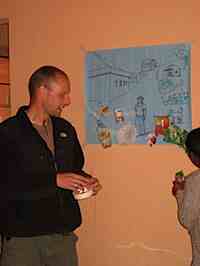  And it’s not just Spanish, though he’s fighting to learn that language in a village where people can hardly speak it, and if they do they usually have more grammatical errors in their speech than Fletch. Additionally he’s whole heartedly trying Q’anjob’al, and once again has been stuck in comparison with me. Our brains work so differently. He can reason out all sorts of technical questions I couldn’t begin to figure. I can memorize just about anything in a flash. Since learning a language, in my opinion, is about 85%-90% memorization and 10%-15% reasoning, the Fletchmeister does not have the upper hand here. But he’s doing it, and I think he’s doing a great job. And it’s not just Spanish, though he’s fighting to learn that language in a village where people can hardly speak it, and if they do they usually have more grammatical errors in their speech than Fletch. Additionally he’s whole heartedly trying Q’anjob’al, and once again has been stuck in comparison with me. Our brains work so differently. He can reason out all sorts of technical questions I couldn’t begin to figure. I can memorize just about anything in a flash. Since learning a language, in my opinion, is about 85%-90% memorization and 10%-15% reasoning, the Fletchmeister does not have the upper hand here. But he’s doing it, and I think he’s doing a great job.
He seems to suffer from something pretty common amongst people in general (I think this might be the case with just about every person I know anyway, and I know it’s true of myself)–a distorted perspective of self in the world. It’s pretty much impossible for people to accurately view, how they fit into their environments, families, friend groups, because they’re always looking from the inside out. I’m not sure he realizes it, perhaps because he always hears a lot of kind criticism (Guatemalans avoid being rude at all costs), but it’s true that Jaime IS everybody’s darling. His darling status entitles him to lots of forgiveness when he makes language faux-pas, such as the time he told the mayor of our Municipality and everyone in the county-wide meeting that the people of Santa Eulalia are not smart enough for a trash system that was being proposed. The mayor, the doctor, the health technician were laughing so hard they were almost in tears. The word lista, depending on the context, can mean either smart or ready. He meant to say they weren’t ready for the system, but instead he just made everyone sound really dumb. HAHAHA. It was pretty funny. And of course, as far as our family goes, they LOVE him here, from the littlest of the kids to the chikay, grandma, everyone wants to hang out with Jaime. Here he is making a chicken coup, and building kites with the boys, and hanging out with Delmy, Reina’s dauther.
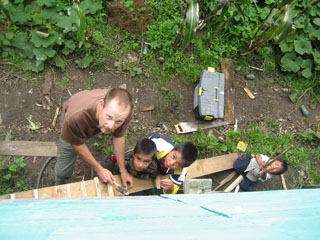 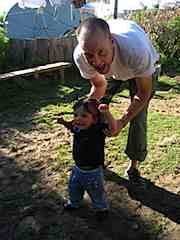 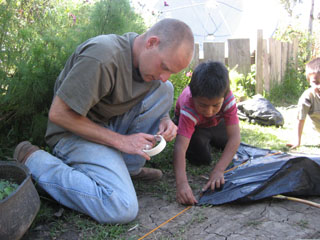
The family has taken to calling him icham Jaime since our family learned that we’re 11 years apart in age. That’s Q’anjob’al for Old Man Jaime. When they’re feeling especially funny they’ll call him isaj icham–lazy old man, and laugh hysterically; he’s lazy because he works on the computer instead of outside like they do. Jaime laughs and plays up their jokes. He does anything and everything to make them laugh. And I have to say I believe it is he who has endeared most of the village to us. Since he bought the traditional capishay and started wearing it around everyone’s smiles have gotten bigger when we show up. Now they ask, “Emily, donde esta tu corte?“–Emily where’s your corte? If Jaime is dressing like them, why am I not also? 🙂
Not only does he keep them laughing, but when things get annoying or frustrating or just downright suck, he manages to  keep me laughing also. He is my cheerleader, but that is far from his only job. And in those moments I think he’s kind of a god-send. I thought for years that this part of my life would be something I’d do alone, and now I can’t imagine it as anything other than what it is now. This experience of ours has turned into one solid team effort. We are, in fact, referred to by many of our fellow PCV’s as Team Fanjoy. So if he ever tries to tell any of you he’s just here to support me in something I wanted to do, you should know that is true, but he’s doing SO MUCH more than just that. He for sure fits into whatever percentage of people are meant to PCV’s, as he proves ever day he’s here being one. You go, Jim Fanjoy. keep me laughing also. He is my cheerleader, but that is far from his only job. And in those moments I think he’s kind of a god-send. I thought for years that this part of my life would be something I’d do alone, and now I can’t imagine it as anything other than what it is now. This experience of ours has turned into one solid team effort. We are, in fact, referred to by many of our fellow PCV’s as Team Fanjoy. So if he ever tries to tell any of you he’s just here to support me in something I wanted to do, you should know that is true, but he’s doing SO MUCH more than just that. He for sure fits into whatever percentage of people are meant to PCV’s, as he proves ever day he’s here being one. You go, Jim Fanjoy.
Posted by: emily
Tuesday, December 16th, 2008 at 8:16 pm
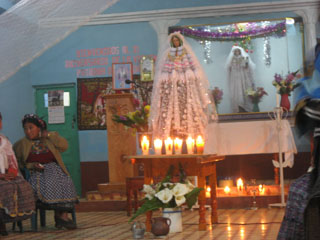
We mentioned the Virgin of Guadalupe earlier, but we’ve now successfully made it through her full festival full of interesting events and funny stories. The official celebrations began on Wednesday night and lasted until Friday night. You can bet there was non-stop marimba music from beginning to end. I don’t mean to be non-participatory in the culture, but that much marimba is enough to make me feel I HATE IT! When it finally ends, I can take a deep breath and move on…But I was about to tell you all some stories.
You should start off by knowing that the Virgin holds a particular significance to the Catholics here in Temux. You see, they’ve only had a Catholic church in the village for the last 14 years, and when they were able to build one they dedicated it to the Virgin. Nas Palas, as usual, told us this story sitting around their cooking fire as it burned down to coals. The Temuxenses credit the Virgin with saving their lives and their village during the civil war. It is said that one night in the midst of the conflict a few soldiers were guarding the colonel’s quarters in some undisclosed location of our municipio, when they spotted a young woman in indigenous dress, the typical Santa Eulalia blouse or huipil– it’s a white lacy affair with stripes of color around the collar–walking alone through the night. That may not sound like a big deal right off, but you need to understand at the time this was an unheard of thing to do. It was during a war. If you’re out at night, under cover of darkness, you’re automatically suspect for being up to no good, and she was a young woman, making her susceptible to beatings and rape. So the story goes that she walked up to the soldiers and asked to talk to the colonel, and amazingly enough she was granted permission to enter and speak with the man. She explained to him in simple terms that her people were a poor and humble people who had done nothing wrong. She made it clear to him that they should not be harmed in any way. And as our village heard the horror stories of what was happening in the nearby towns and villages, their village, and in fact our entire municipio went almost entirely unharmed, physically for the entire conflict. It is said that the señorita walking alone in the night was in fact the Virgin Mary, and that is why the church was named in her honor, and why the town celebrates the appearance of the Virgin of Guadalupe–that was the closest “legitimate” appearance of their guardian.
That said, we will get on to the party. It’s a big deal, about as big a deal as Guatemala’s Independence Day Celebration. The former, like the latter, involves sending a delegation of people to Panajachel to light a torch which they carry back with them to the village, and all the young delegates come running into town with torches lit from the flame that traveled north with them. It’s all very glorious. But we didn’t know about this part as we were hanging out in the family’s kitchen and someone asked if we were going dancing tonight, then someone asked if we were going to watch the torch come in to the village, then somehow the idea of a corte came up, then the corte–their traditional skirt– was talked about as a thing I would wear. And before I knew it, I was in the back room with all sorts of onlookers, men and women and children, as I changed/was changed into their traditional dress. Here you should know that women and men in town have been asking me since probably a week or so after our arrival when I was going to put my corte on. Apparently, this was the moment they’ve all been waiting for.
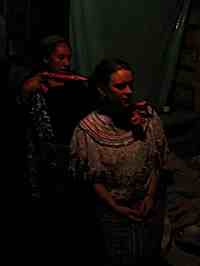 Reina led the effort, coming up with a new corte that, I think, belonged to her; finding me a suitable huipil and sweater; then braiding my hair. This is funny to me because Reina doesn’t like to be overly social. She doesn’t like dancing. She doesn’t really like participating in any religious celebrations. She likes to be at home with her family, keeping to herself when she’s not out working at the health center. Part of the reason I like her so much is that she has an opinion about things and more importantly, unlike most Guatemalans, she’ll share it with you HONESTLY–that’s a big deal to me. So although dressing me up didn’t really seem like it would be her “thing” she was surprisingly into the effort. During all of this Fletch and I had managed to lock ourselves out of our house. He and Galindo somehow got Galindo through the tiny window, which is located a good 15 feet off the ground, to unlock the door and bring me my grandma’s black loafers so I wasn’t wearing my hiking boots with the outfit. Reina braided the ribbons into my hair and as I put the huipil on while everyone watched and spoke quickly in q’anjob’al so that it was almost all entirely lost on me, little Michelle, who comes up to my knees, was looking up at me and stroking my newly dressed legs in amazement at the giant woman in chan, that’s dialect for corte. As she was looking up at me, her grandpa, Nas, was talking to her, and I saw in her very expressive face that her eyes bulged out for a moment frozen in time before she quickly looked away. “Que dijo, Nas?” I asked him what he said. “Nada,” he said with a smile. I kept asking everyone around me, “What did he say?!” I wanted to know why her eyes had turned the size of saucers, and no one would translate for me. Finally, Nas admitted, “I said, ‘Now she’s no longer Emily; she’s the Virgin of Guadalupe.'” That would do it. I had essentially turned to a ghost-like being in front of this nearly 3 year old girl. They had dressed the unwitting me as the picture of the señorita, their Virgin, who saved them all from an ugly fate. I remembered Chalio telling Reina the second day we were here that we must have fallen from heaven because he’d never seen people who looked like us before. Perfect, I thought, and now I’m the Virgin too. I am a virgo, but still. Reina led the effort, coming up with a new corte that, I think, belonged to her; finding me a suitable huipil and sweater; then braiding my hair. This is funny to me because Reina doesn’t like to be overly social. She doesn’t like dancing. She doesn’t really like participating in any religious celebrations. She likes to be at home with her family, keeping to herself when she’s not out working at the health center. Part of the reason I like her so much is that she has an opinion about things and more importantly, unlike most Guatemalans, she’ll share it with you HONESTLY–that’s a big deal to me. So although dressing me up didn’t really seem like it would be her “thing” she was surprisingly into the effort. During all of this Fletch and I had managed to lock ourselves out of our house. He and Galindo somehow got Galindo through the tiny window, which is located a good 15 feet off the ground, to unlock the door and bring me my grandma’s black loafers so I wasn’t wearing my hiking boots with the outfit. Reina braided the ribbons into my hair and as I put the huipil on while everyone watched and spoke quickly in q’anjob’al so that it was almost all entirely lost on me, little Michelle, who comes up to my knees, was looking up at me and stroking my newly dressed legs in amazement at the giant woman in chan, that’s dialect for corte. As she was looking up at me, her grandpa, Nas, was talking to her, and I saw in her very expressive face that her eyes bulged out for a moment frozen in time before she quickly looked away. “Que dijo, Nas?” I asked him what he said. “Nada,” he said with a smile. I kept asking everyone around me, “What did he say?!” I wanted to know why her eyes had turned the size of saucers, and no one would translate for me. Finally, Nas admitted, “I said, ‘Now she’s no longer Emily; she’s the Virgin of Guadalupe.'” That would do it. I had essentially turned to a ghost-like being in front of this nearly 3 year old girl. They had dressed the unwitting me as the picture of the señorita, their Virgin, who saved them all from an ugly fate. I remembered Chalio telling Reina the second day we were here that we must have fallen from heaven because he’d never seen people who looked like us before. Perfect, I thought, and now I’m the Virgin too. I am a virgo, but still.
A funny side note: I really was not able to see how they tied me up in what is essentially yards and yards of fabric (think, same concept as a traditional Scottish kilt), with a belt. Because Reina wasn’t coming with us and I had no idea how to re-tie myself if it started coming loose, she tied me in there tightly. I haven’t felt so constricteded since I duct-taped my boobs down for a play in college that mixed up gender roles. Holy cow, I could hardly breathe. In the mean time Fletch had donned his capishay and hat, and we sat around stuffing down tortillas and beans to our host sisters’ urgings, “lim!”–hurry up! The torch was coming to town soon and they didn’t want to miss it. I did feel sort of like I was, again, in some bizarre play, acting the part of an indigenous woman in my traje, eating tortillas and beans around the fire with the family. As I waited in the mud and dark outside of our house, Nas’s tiny little niece walked up to me and said in an equally tiny whisper, “Emily, eres muy hermosa”–Emily, your very beautiful. Then she ran off in the dark.
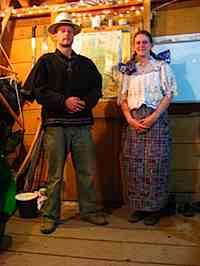
We made it to the church in time to see the runners coming up from the bridge that marks the border of our village. Waiting in the dark, no one seemed to notice our clothing or rather notice that it was US in that clothing, but the moment we walked down in to the church yard we were greeted by the village mayor who led us past everyone (pretty intentionally past everyone he could think of), down behind the church to where a kitchen was FULL of women preparing a big dinner for all the participants of the celebration, the runners, the church leaders committee, and, apparently, us. My first thought was, “Crap, I just shoveled down a meal. I can’t breathe and now they’re gonna make me eat again.” 🙁 The crowd of women in the kitchen were, well, I think THRILLED would accurately describe their response to our outfits. The smiles on their faces could not have gotten any bigger; there was applause; the older women in the bunch came and hugged both of us in their gentle, awkward way (hugging doesn’t seem to be a natural gesture here, and I can’t quite explain it but to say that it’s very awkward, where the heads go, where the arms and hands meet, very awkward, but they do it because they mean well). The chikays, grandmas, in the room were so beside themselves they couldn’t speak. Some of the younger women we’ve gotten to know well through our health charlas just kept saying, “It’s so wonderful to see you dressed like, like us.” We hadn’t been running in the cold and dark with torches, but we had put on the traje, so we got seated and served first, and then many women took shifts watching us eat with near busting smiles. “Lowan, lowan, lowan!” They do this thing here, where while you’re eating, they tell you, “Eat, eat, eat,” as though you aren’t already, as if to say, “Go on, don’t be
 shy, dig in,” except you already are, so we just kept saying, “Thank you, thank you, thank you,” and methodically spooning the chicken soup in. All of our dinner company was excited to talk to us, test our knowledge of Q’anjob’al, and take pictures of us on their cell phones, not kidding, while two dead, recently-skinned sheep hung from the ceiling rafters off to our right. I knew they were recently skinned because the bones still had all the meat on them, and one sheep’s leg had slipped loose of the tie so it appeared to be dancing upside down from the rafter. Sometimes, things here are just very incongruous. Anyway, here is a picture of us in traje drinking our coffee. We picked up our cups so, as our photographer suggested, so “we can tell what you’re doing.” shy, dig in,” except you already are, so we just kept saying, “Thank you, thank you, thank you,” and methodically spooning the chicken soup in. All of our dinner company was excited to talk to us, test our knowledge of Q’anjob’al, and take pictures of us on their cell phones, not kidding, while two dead, recently-skinned sheep hung from the ceiling rafters off to our right. I knew they were recently skinned because the bones still had all the meat on them, and one sheep’s leg had slipped loose of the tie so it appeared to be dancing upside down from the rafter. Sometimes, things here are just very incongruous. Anyway, here is a picture of us in traje drinking our coffee. We picked up our cups so, as our photographer suggested, so “we can tell what you’re doing.”
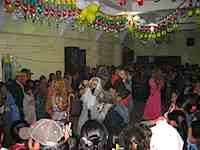 As dinner ended we headed back up to the church where every was congregating in the meeting hall. We waited outside a while for things to get settled in the salon and ended up talking with a woman we know well from the charlas, “You look like Mary and Joseph,” she said. I had to wonder why? Is this a bad thing because they see their god as a caucasion, or is this a good thing that they see their God wearing the traditional traje? I fear it’s more the former than the latter, but who really knows. One things for sure, me in a traje invokes images of the Virgin around here. We went into the salon and were given seats of honor on the stage until the beauty pageant began and they stuck us off the to the side, much to our relief. This was also a mini-version of the independence day beauty contest we judged in September. Thankfully, we weren’t judging this one, and the candidates and winners were all worked out beforehand, so there was just some 2 hours of handing over crowns and parading in and out of the salon. We were so tired, and I so could not breathe, as the whole thing seemed to finally be coming to an end. First came the convite, a dance of masked and costumed folk that is pretty traditional at every fiesta here. Why? We still have no idea. Among the demons and wizards was a George Bush mask, which made us laugh. Then the folk dancers came sweeping into the room with their handkerchiefs waving and bare feet jumping to get the music and dancing started. We were pulled in to the first round of dancing, and continued for 3 sets of marimba before we literally danced our way out the door and walked home under a big, full moon to go bed, way past our bedtime. And you should all know, we had no prior notice of anything other than dancing happening this night. We’re pretty much always in for surprises here. As dinner ended we headed back up to the church where every was congregating in the meeting hall. We waited outside a while for things to get settled in the salon and ended up talking with a woman we know well from the charlas, “You look like Mary and Joseph,” she said. I had to wonder why? Is this a bad thing because they see their god as a caucasion, or is this a good thing that they see their God wearing the traditional traje? I fear it’s more the former than the latter, but who really knows. One things for sure, me in a traje invokes images of the Virgin around here. We went into the salon and were given seats of honor on the stage until the beauty pageant began and they stuck us off the to the side, much to our relief. This was also a mini-version of the independence day beauty contest we judged in September. Thankfully, we weren’t judging this one, and the candidates and winners were all worked out beforehand, so there was just some 2 hours of handing over crowns and parading in and out of the salon. We were so tired, and I so could not breathe, as the whole thing seemed to finally be coming to an end. First came the convite, a dance of masked and costumed folk that is pretty traditional at every fiesta here. Why? We still have no idea. Among the demons and wizards was a George Bush mask, which made us laugh. Then the folk dancers came sweeping into the room with their handkerchiefs waving and bare feet jumping to get the music and dancing started. We were pulled in to the first round of dancing, and continued for 3 sets of marimba before we literally danced our way out the door and walked home under a big, full moon to go bed, way past our bedtime. And you should all know, we had no prior notice of anything other than dancing happening this night. We’re pretty much always in for surprises here.
We’d canceled our language class the next day (and since then we’ve officially decided to never hold language class the day after there is to be any sort of celebration in town, because we don’t really get to sleep). The marimba that stopped at midnight started up again at 5 am, along with the bombas, exploding mortars, then there were town announcements over the loud speakers regarding…we have no idea, as we never do, because we can’t understand them. This was Thursday and there was supposed to be more dancing that night. The problem with having marimba music pulsing through town all day, if you want the gringos to come dance at night, is that by the time we’ve listened to it ALL DAY LONG we’re so sick of it there’s no way we want to get closer to it for dancing, come nighttime. So we decided to stay in and not go dancing. That was going well until one of our host sisters knocked on the door and, not asking, said, “Let’s go! Hurry up, the procession is starting!” Having no clear idea of what this was about, or what our roles in it would be, we just put on our warmest clothes and followed her out and down the road to the church. We got there in time to see a crowd of people walking up the narrow path from the 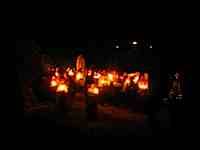 churchyard to the road with a statue of the Virgin hoisted on to some shoulders. The women had their shawls over their heads, arms full of cala lillies and bundles of daisies, hands full of think candle sticks all burning together like great wax torches. There were musicians following the statue leading religious songs in Q’anjob’al, which I could kind of understand, being mighty familiar with Catholic rhetoric and having already studied the appropriate words for family and body parts which are so often referenced. As the procession came upon us, an older lady handed me four candle sticks. I gave two to Fletch and we joined in the procession. The lines stopped moving every twenty feet or so to set off fireworks; bombas that echoed across the valley, lines of black jacks, roman candles, and occassionally the big fireworks we’re used to on the fourth of July shooting spiders of color across the sky, oh and whistlers shot around all around us, screaming as they went by, throughout the entire procession. As we stopped and started everyone struggled to keep their candles lit against the wind that was blowing a great mass of clouds in behind us. Women and children would pluck bundles of leaves off the side of the road to surround their candles, protecting them from the wind and eventually catching fire themselves, making the flame bigger and harder to put out. The moon was full and stars shone where there were no clouds, so while everyone’s faces where illumintated by the yellow candle light, looking beyond the procession we could see all the way across the valley to the mountains on the other side as low-lying clouds closed in around them below us. churchyard to the road with a statue of the Virgin hoisted on to some shoulders. The women had their shawls over their heads, arms full of cala lillies and bundles of daisies, hands full of think candle sticks all burning together like great wax torches. There were musicians following the statue leading religious songs in Q’anjob’al, which I could kind of understand, being mighty familiar with Catholic rhetoric and having already studied the appropriate words for family and body parts which are so often referenced. As the procession came upon us, an older lady handed me four candle sticks. I gave two to Fletch and we joined in the procession. The lines stopped moving every twenty feet or so to set off fireworks; bombas that echoed across the valley, lines of black jacks, roman candles, and occassionally the big fireworks we’re used to on the fourth of July shooting spiders of color across the sky, oh and whistlers shot around all around us, screaming as they went by, throughout the entire procession. As we stopped and started everyone struggled to keep their candles lit against the wind that was blowing a great mass of clouds in behind us. Women and children would pluck bundles of leaves off the side of the road to surround their candles, protecting them from the wind and eventually catching fire themselves, making the flame bigger and harder to put out. The moon was full and stars shone where there were no clouds, so while everyone’s faces where illumintated by the yellow candle light, looking beyond the procession we could see all the way across the valley to the mountains on the other side as low-lying clouds closed in around them below us.
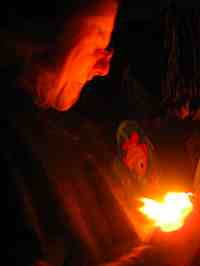
On top of all that, the guitar music was so simple and sweet that looking around, taking everything in, before I knew it I burst into tears and had to shut it off just as quickly for fear that someone would see me. People here are always worried that we might be sad because we miss our families or some such thing, and I didn’t want to ruin their procession by making them worry. We just kept walking as they said Hail Mary’s and sang songs, walking all the way up to the school entrance, before turning around and walking back to the church. The candles were getting low and the wind was getting stronger, so they’d go out, and we’d relight, then they’d go out again. Everyone was holding on until their candles were just the tiniest stubs. It was so cold the little heat they gave off helped keep our fingers warm, but I threw my down when they suddenly started to burn my fingers. Here is a picture of Fletch as he realized his fingers were burning too, so without thinking he threw his candle stubs and they landed, still lit, on the little girl in front of him. : ) Lucky for us, they think everything we do here is funny, so she just laughed hysterically in spite of us all trying to be appropriately solemn. Then she held my freed hands all the way back to the church, a big smile on her face. Ahh, those ridiculous gringos.
There was one more great display of pyrotechnics at the entrance to the church before placing the Virgin back on the altar. The statue’s entrance was followed by the congregation filing in and kneeling to begin their final prayers before the dancing began again. This was the moment I stayed by the back door and slipped away as the prayers started so I could go home and get in my warm bed again. I was not into the idea of dancing, but I was glad we’d come out for the procession, all thanks to Masha and her orders. It was really beautiful.
I stuck my earplugs in to block out the marimba and thought that I’d call it a night, which I managed to do pretty successful until about 3 in the morning. Our host mom came knocking on the door. Fletch heard her, and I couldn’t hear anything, but suddenly he was out of bed, the lights were on, and 4 women of various ages were standing in our kitchen. Since Fletch was running around I decided to play dumb and pulled the blankets over my head again.
He filled me in the next morning and I laughed hysterically at his story: when he opened the door to them calling my name they asked, “Podemos usar unos huevos?” and, though asking if they could have some eggs at this hour was a bit strange, he turned to pick up two eggs and as he turned around to hand them to Lina she had entered the house and looked at him like he was insane. She repeated, “Podemos usar tu fuego?” She wanted to use our stove because her cooking fire was out (it was, after all, 3 am). She pointed out to the yard where a young man was vomiting in the bushes. She explained it was her daughter’s brother-in-law, who is evangelical therefore ideally doesn’t drink, and someone had given him alcohol. He thought he was going to die, and they decided that giving him some warm beer would probably help the problem. Why? I have no idea. Can anyone out there tell me if this is a legitimate cure, we’ve also heard warm beer is a good thing to drink if you have diarrhea? I do know they couldn’t have given him cold beer because it was a cold night, and you should only drink warm things on cold nights or it will mess with your constitution. So Fletch turned a burner on and they warmed the beer in a tin cup and left us to go back to bed. We woke up about 15 minutes before our language instructor got here on Friday morning, pretty unexcited about class.
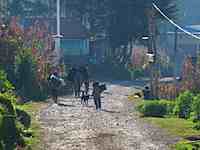
The marimba music and bombas had also begun at 5 am that morning, just as the day before. When Pedro showed up we explained all the weirdness (maybe it’s normal for him, but it’s definitely weird for us). He said, “Yeah, but they don’t play the music on those speakers all day and night.” We told him, in fact, they do. “They shouldn’t do that!” was his only response. We couldn’t agree more… Suddenly I saw a donkey walking down the road with yet MORE SPEAKERS attached to its back, headed in the direction of the church. I told Fletch and he ran out with his camara in hand. All I could think was, “Ay, mundo…” which is a colloquial expression that means roughly, “oh, lord.” We did all we could about that situation. Which is to say we made some pancakes and coffee and sat out in the sun where it was warm to eat it all and, of course, listen to the marimba. I couldn’t have felt less excited about the two hours of class we were supposed to have after breakfast.
As we were finishing up breakfast we noticed our host family across the way was trying to move their huge laundry stone back up the hill and next to the stream. When the digger came to level out spaces for new houses a week ago, the stone was moved and then covered in dirt, but it’s a pretty perfect stone on which to wash clothes so they’d decided to try and rescue it. Pedro and Fletch went flying over to help them out.
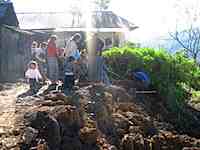 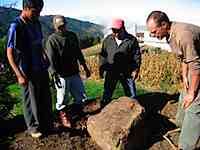 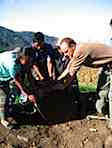 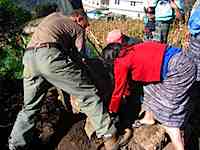
This is when I decided there was absolutely no way I was going to sit inside for class this beautiful day. I told Pedro so, and explained that we should sit around with the family while they speak in Q’anjob’al and try and figure out what they’re saying. He could guide the conversation around to things we’ve studied so far. Thus we sat outside in the sun under a beautiful blue sky and had what was the closest thing to our first conversation with our host family in their language. It was a good day even if we were forced to listen to marimba for the duration of it. We did not go dancing the last night of festival. Instead, we went to bed early and prayed no one would wake us up neither for eggs nor fire. And thus ended the festival of La Virgin de Guadalupe.
Posted by: emily
Sunday, December 14th, 2008 at 9:25 am
Our chicken project continues. My friends Brian and Mel are pursuing their own chicken project in the US on a timeline roughly similar to ours, so its sortof the International Chicken Brotherhood. Brian’s chicken coop is WAY more elaborate than ours- as ours is done in the local style. [update: he just finished it] This made me think of posting some gallinero (chicken coop) pictures online, for everyone’s enjoyment. If you don’t care about chickens, then you might want to skip the rest of the post
The Gallinero Gallery
 |
 |
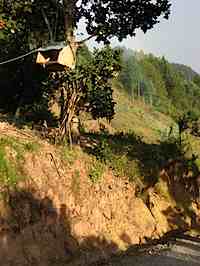 |
| This is our gallinero I built a few weeks ago, hanging from the side of our house. We still don’t have any chickens yet 🙁 Also, since it’s getting cold, I’m going to add a lightbulb heater this weekend. |
Most of the coops here are built on stilts, I guess to protect against predators (I’ve never seen any). They have removable chicken stairs. |
Or, if you don’t like stilts, you can just hang it from a tree with rope. |
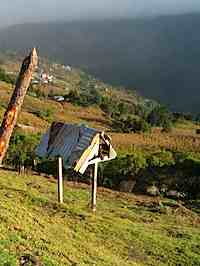 |
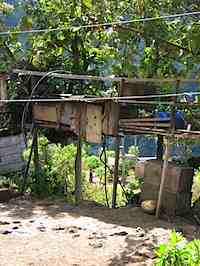 |
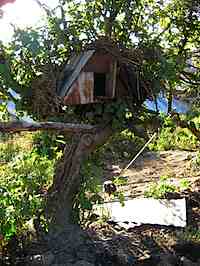 |
| This is one of my favorites, an archetype I see a lot of: a triangle, with scraps of roofing steel to cover it. This one has a GREAT view. |
This one’s at our neighbor Petronela’s house. She stores her harvested greens in the elevated, caged box next to it. I don’t know why. |
This one looks like a kid’s treehouse, but is another great place for chickens to spend the night. |
 |
|
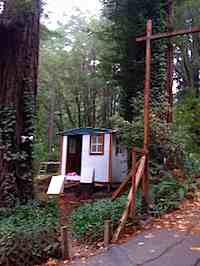 |
| This gallinero is right along the road as we come into town. I took this picture as the sun was setting (as you can see). |
This coop belongs to the lady we’re going to buy our chickens from. She says they prefer to roost in the nearby trees at night. What can you do? |
And, for comparison, here’s Brian’s chicken coop. Double pane windows, insulation, a heater, a DOOR… it’s nicer than any house I’ve ever seen in Guatemala. 🙂 |
|
|
|
So, now I will share some funny chicken stories. The other day, Emily and I were walking through town and came across a lady and her elderly mother, who was sitting on a pile of firewood. We chatted with the lady, and she mentioned that her mother (a granny) was sitting because she is very tired, as she has diabetes. The granny was just sortof watching us talk, as she didn’t speak Spanish. She looked at peace. Meanwhile, their chickens were going about their business in the yard, scrathching and pecking. Their rooster at the edge of the yard was crowing occasionally, something I don’t notice much anymore.
As we contined talking, I noticed the rooster strutting its way across the yard towards the grandmother. I hate roosters, by the way, because of their cocky attitude (pun intended). Anyways, this was a really big rooster, and he walked all the way across the yard and right up to the granny, who was paying attention to us. He then cocked his head, looked at the granny, and belted out a LOUD “cock-a-doodle-doooooooo” right at her. The old lady must have leapt a foot in the air, from her seat atop the woodpile. It was hilarious, and took all my self control not to bust out laughing.
The granny was not amused. Her face turned into a big, prunish frown and she glared at the rooster. Then, with no warning, she hucked a piece of firewood at it! The rooster make a loud clucking noise, flapped its wings, and took off. This was even more hilarious. Satisfied that justice had been done, the granny settled back down and continued to watch us.
Right, so that’s it for the Chick Page. Oh, and I was transplanting some of our broccoli today, and one of the neighbor hens came into our yard (if you can call it a yard) and brought her chicks. I could hear their peeping 10 yards off. Here are some pix:
 
Posted by: jfanjoy
Saturday, December 13th, 2008 at 12:23 pm
The locals are restless. Living in Central America, one might expect the occasional civil unrest, and we sortof knew this kind of thing happens when we joind Peace Corps. But besides the stone-throwing incident, our time here has been EXTREMELY peaceful. After the civil war ended in 1996, the Guatemalans were pretty sick of violence and reverted to a pretty laid-back, pacifist lifestyle. Except in Guatemala City, where they have a gang problem. And we don’t go there.
Then Friday came along. Reports dribbled in from lots of different sources, and it seems that there was a secuestrado (kidnapping) last week in Soloma, and a contract killing in Barrillas, both towns about an hour from Santa Eulalia. These things happen in Guatemala sometimes, with CA$H being the primary motive. Anyways, on Friday the general citizenry somehow found out who was involved, and that the suspects live in Soloma (an hour in the other direction). Then, something bad happened. The police here are largely ineffective (poorly funded, unmotivated, and sometimes corrupt), so mob vigilante justice takes over if a criminal element gets too brazen and the people get fed up enough. In this case, the mob went to the guy’s house and “coerced” him to tell who his accomplices were. By the end of the evening, five of the kidnapping gang were dead. At least we hope they were actually the kidnappers, as there was no trial, obviously. We also hear that two escaped. Since usually only criminals can afford guns here, the mob either either kills their victims by axehandle and machete, or by lighting them on fire. For all you Spanish students, the applicable nouns here are linchamiento (lynching) and quemado (immolation, or burning). Update: We have since learned that three of the five killed were aged 14, 16, and 18. They were brothers, and their father (who escaped) is supposedly the ringleader of the gang. He turned up Sunday in Santa Eulalia, having hung himself in his girlfriend’s house.
Weird thing was, we were planning on going to Soloma yesterday to go to the bank. Our friend Pedro warned us that it might not be a good idea. “Really?” I asked him. “I wasn’t THAT worried for our safety; they know that Gringos aren’t involved in the local criminal element.” It’s nice of others to be concerned with us, and I agree it’s better safe than sorry, despite the fact that we’re pretty hard to mistake for locals.
“Actually,” he replied, “I was just thinking that the traffic will be terrible.” Nice.
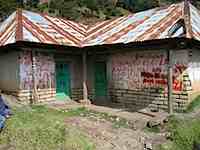 So, that afternoon, our neighbor Manuel came over to tell us there’s been vandalism in our town! This sort of thing is unprecendented here, as we are WAY out in the boonies, and everyone here knows everyone else. Turns out, an abandoned house across the street from the Health Center (and about 50 yards from our house) was tagged pretty badly last night. It says nice things like pendejo, and vamos a pelear con todos de Temux and stuff like that. The handwriting and grammar are in general pretty 2nd-grade, but what can you expect- even our town leaders only got to third grade. Heck, i just think it interesting the graffitti was all in Spanish, not Q’anjob’al. So, that afternoon, our neighbor Manuel came over to tell us there’s been vandalism in our town! This sort of thing is unprecendented here, as we are WAY out in the boonies, and everyone here knows everyone else. Turns out, an abandoned house across the street from the Health Center (and about 50 yards from our house) was tagged pretty badly last night. It says nice things like pendejo, and vamos a pelear con todos de Temux and stuff like that. The handwriting and grammar are in general pretty 2nd-grade, but what can you expect- even our town leaders only got to third grade. Heck, i just think it interesting the graffitti was all in Spanish, not Q’anjob’al.
“Can you take fingerprints?” Manuel asked. “They do that in the US! We can catch these guys!”
I sighed a deep sigh. This man watches WAY too much CSI. “No, Manuel… they would have to have touched the house. And they only touched their brushes and spray cans, which we don’t have. Besides, we don’t have the tools or expertise for fingerprinting.” I didn’t mention that we also lack a massive computerized database of known offenders.
He seemed doubtful; perhaps I was withholding aid. “I bet the police in America could handle this.”
I apppeased him by giving a speech (in Spanish!) to him and the assembled townsfolk, a few dozen of whom had gathered since we started the discussion. “Yes, the police in the US would do something. They have specialists who take pictures of the graffitti, and keep a database, and match it up with other known samples. Then, do you know what they do?” I paused dramatically. “They paint it over immediately. This sends a message to whoever did it that they will not be successful with this attack. If you leave it, it will encourage more. You need to act now as a town to change this. I already took pictures of it, so we have them if we should ever need to compare it to others in the future.”
So, the next day I was at the store getting 4 eggs, and there was a BIG village meeting going on in the community hall across the street (bear in mind that ALL of this happens within a 200 yard radius; our town is pretty small). “What’s that all about?” I asked Palxun, the store owner.
He jerked his head to the next building up the road, the house that had been tagged. “They’re meeting about the damage from yesterday.”
The meeting went on for hours. At one point, we were visiting our neighbors, and we heard a HUGE ruckus down at the town hall. A half-hour later, Nas Palas returned, having attended the whole meeting. Turns out, everyone sortof figured out who did it (again, small town). Then, some other lady who is friends with the tagger’s mom said that SHE did it, apparently in a move to protect the kid. “Wait,” I asked. “That lady can’t even write, can she?” Turns out, the village elders thought of that angle too, and then the lady said she sent her daughter to actually do the painting. What a mess. I don’t know what the end result with the “guilty parties” will be, but no one was sharpening machetes or filling coke bottles with gasoline, so that’s a relief.
HOWEVER, this all has had a larger result, at the regional level. All of the alcaldes auxiliares (village vice-mayors) met in Santa Eulalia, and decided to re-institute “night watch patrols”, something they haven’t done since the war. It’s like a cross between our “Neighborhood Watch” and the Michigan Militia: bands of a half-dozen citizens walking the roads during the night, stopping anyone whot’s out, checking what their business is. Nas was quick to point out that they wouldn’t be responsible for “fighting crime”, they are there to watch for suspicious activity. And if someone is out and has some sort of emergency, the patrol is supposed to help. Males aged 12 and up are asked to be involved. Emily and I looked at each other like, “WHAT?!” then I realized, this might actually be a good idea. It teaches the kids about civic responsibility, and Lina then explained that there would always be a fair number of older, more responsible men in any given patrol. Hmmmm. Still don’t know exactly how I feel about that.
Of course, this could all be worse. I bumped into another volunteer when i was in Huehue last week, and she told me that she was hanging out in the city for a while because our security director told her to not go home for a few days, until things settled down. Turns out, the town up the street from hers (the one she has to change busses in) had a big shootout. I guess that’s what happens when you put a Mexican drug gang, a Guatemalan drug gang, a ton of alcohol, and a horse race together in the same place. The wrong guy won, and everyone broke out the AK-47s and grenade launchers. About 2 dozen people got killed. Thankfully, that kind of stuff doesn’t happen within 5 hours of where we are.
So, on that happy note, here’s a picture of the neighbor’s christmas tree next door.

Posted by: jfanjoy
Thursday, December 11th, 2008 at 12:04 am
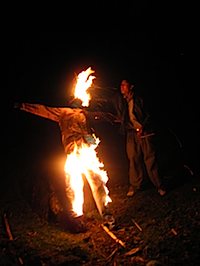 No, I am not listening to Twisted Sister from the 80’s. I am talking about la fiesta de la virgen de Guadalupe. It seems that sometime in the 19th century, the apparition of the Virgin Mary appeared to some country folk in Mexico. They mentioned it ot the Pope, the Vatican declared it a miracle, and now it’s a HUGE holiday all throughout Latin America. To open the celebrations, they make effigies of Satan and when the sun falls on the first day, they light him on fire. Gasoline and bandoliers of fireworks around his torso help. No, I am not listening to Twisted Sister from the 80’s. I am talking about la fiesta de la virgen de Guadalupe. It seems that sometime in the 19th century, the apparition of the Virgin Mary appeared to some country folk in Mexico. They mentioned it ot the Pope, the Vatican declared it a miracle, and now it’s a HUGE holiday all throughout Latin America. To open the celebrations, they make effigies of Satan and when the sun falls on the first day, they light him on fire. Gasoline and bandoliers of fireworks around his torso help.
 They made the effigy the afternoon before. Here we have Alberto, hugging his beloved Satan. In a surreal combination of holidays, they were also putting up the Christmas tree a the same time. Much like at the Health Center, they don’t actually cut down a tree- they chop off a whole bunch of pine & cypress branches, make a teepee frame of wood, then tie the branches on. Saves killing a tree, and makes a “christmas tree” that is quite dense and full looking. Though, i am not sure it’s very good for the tree that got trimmed. They don’t seem to have much concern for being careful, and they were lopping off some BIG branches. Guatemala is very thirld-world. Here are some pictures, in a sequence, of how the whole thing went. They climb pretty high to cut the limbs; this is also how they get firewood half the time, so they’re pretty good at it. Though, it can be dangerous- there’s a one-eyed man in town that got that way collecting firewood, and he was telling me about someone else that died falling out of a tree. They made the effigy the afternoon before. Here we have Alberto, hugging his beloved Satan. In a surreal combination of holidays, they were also putting up the Christmas tree a the same time. Much like at the Health Center, they don’t actually cut down a tree- they chop off a whole bunch of pine & cypress branches, make a teepee frame of wood, then tie the branches on. Saves killing a tree, and makes a “christmas tree” that is quite dense and full looking. Though, i am not sure it’s very good for the tree that got trimmed. They don’t seem to have much concern for being careful, and they were lopping off some BIG branches. Guatemala is very thirld-world. Here are some pictures, in a sequence, of how the whole thing went. They climb pretty high to cut the limbs; this is also how they get firewood half the time, so they’re pretty good at it. Though, it can be dangerous- there’s a one-eyed man in town that got that way collecting firewood, and he was telling me about someone else that died falling out of a tree.
  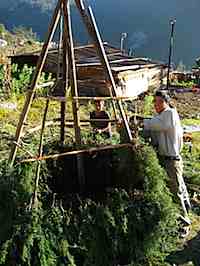 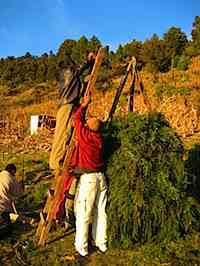
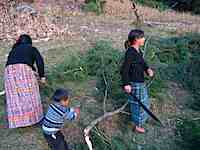 By the way, that’s Galindo in the thrid and fourth pictures. He is doing a lot better now, so thank you to everyone that sent prayers and well-wishing. By the way, that’s Galindo in the thrid and fourth pictures. He is doing a lot better now, so thank you to everyone that sent prayers and well-wishing.
This tree thing definately was a family event. Everyone drew their machetes and started breaking down the bigger branches. And I mean EVERYONE, the girls, the women, even the toddlers. Check out the two-year-old wailing away with the broadsword (click to enlarge). I made sure to stay WAY clear of that action, but they seemed completely unconcerned. Though, the doctor once told me that 90% of physical injuries he treates are machete inflicted.
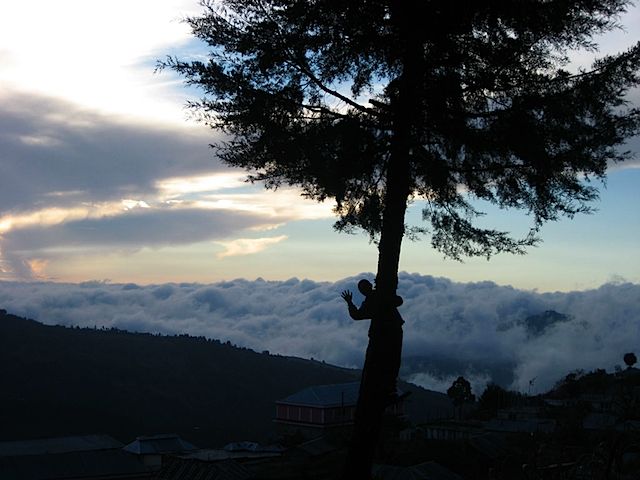
 And, as we were all making the tree, Lena cut up some sugarcane that my Q’anjob’al teacher brought me the day before (there is NO WAY Emily and I can eat all that by ourselves). Everyone here loves sugarcane. Maybe that is why they have no teeth. And, as we were all making the tree, Lena cut up some sugarcane that my Q’anjob’al teacher brought me the day before (there is NO WAY Emily and I can eat all that by ourselves). Everyone here loves sugarcane. Maybe that is why they have no teeth.
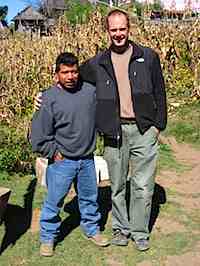 Speaking of my Q’anjob’al teacher, here he is. His name is Pedro, and he’s a pretty nice guy. He has a lot of odd jobs besides teaching us the Mayan dialect- he grows mushrooms, translates Spanish to Q’anjob’al for videos, and farms some land in Barrillas (a nearby village where the sugar cane came from; it’s too cold here in Temux). He’s a really nice guy, and I appreciate the fact that he’s one of the few people in the region that thinks beyond his daily, hand-to-mouth needs. You might notice that he is quite short. That is the norm here, partly due to genetics, partly due to a LOT of hunger & malnutrition during the civil war in the 80s, when he was growing up (he’s the same age as me). Speaking of my Q’anjob’al teacher, here he is. His name is Pedro, and he’s a pretty nice guy. He has a lot of odd jobs besides teaching us the Mayan dialect- he grows mushrooms, translates Spanish to Q’anjob’al for videos, and farms some land in Barrillas (a nearby village where the sugar cane came from; it’s too cold here in Temux). He’s a really nice guy, and I appreciate the fact that he’s one of the few people in the region that thinks beyond his daily, hand-to-mouth needs. You might notice that he is quite short. That is the norm here, partly due to genetics, partly due to a LOT of hunger & malnutrition during the civil war in the 80s, when he was growing up (he’s the same age as me).
 So, now I will post some random stuff. This one is for my dad, who likes ducks. Here was have the neighbors’ pech, or ducks. They are quite happy now, as they can play in puddles that are left by some construction that just happened. This is where a house will go in a few years, once that family can save some more money. But they had enough to get the earthwork done, so they did it this week when the backhoe was in town for a few other projects. So, now I will post some random stuff. This one is for my dad, who likes ducks. Here was have the neighbors’ pech, or ducks. They are quite happy now, as they can play in puddles that are left by some construction that just happened. This is where a house will go in a few years, once that family can save some more money. But they had enough to get the earthwork done, so they did it this week when the backhoe was in town for a few other projects.
 Remember the pretty corn we harvested in Guatemala? Well, their beans (or ub’al, in dialect) are equally beautiful. Check out these gems, they look like Berti Bott’s Everyflavor Jellybeans. I want to bring some back to plant in my garden when we’re done with Peace Corps. Remember the pretty corn we harvested in Guatemala? Well, their beans (or ub’al, in dialect) are equally beautiful. Check out these gems, they look like Berti Bott’s Everyflavor Jellybeans. I want to bring some back to plant in my garden when we’re done with Peace Corps.
And, some pictures of us doing our housework this week. That’s about it for now.
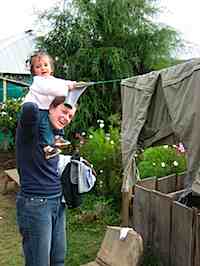 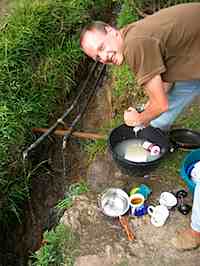
Posted by: jfanjoy
|
|
|
 Our first job was to put it together, load it, and light it up- in the front yard. You see, the factory-applied paint has to bake on the rest of the way with the first firing, and it gives off a lot of stink that you don’t want in your house. So, here we are, enhancing our image as “weird white people that do totally inexplicable things.” Never mind that we tried to explic to everyone who wandered by; they didn’t get it.
Our first job was to put it together, load it, and light it up- in the front yard. You see, the factory-applied paint has to bake on the rest of the way with the first firing, and it gives off a lot of stink that you don’t want in your house. So, here we are, enhancing our image as “weird white people that do totally inexplicable things.” Never mind that we tried to explic to everyone who wandered by; they didn’t get it. That evening was torturous to Emily, who was cold but KNEW that our stove was sitting right outside, doing us no good. So, at first light the next day, i sprang into action, breaking stuff and causing a general mess so that I could install the chimney. I cut a hole in the wall, and made a sheetmetal orifice for the stovepipe to keep the heat clear from our highly combustible, made-from-kindling wall. They only sold sheetmetal in giant coils in town, so I ended up buying a sheetmetal bucket for Q20 (about $3) and cutting it apart with aviation shears in my Peace Corps (TM) Tool Kit. Check out the rain diverter hat I made for the stovepipe, too: it’s the bottom of the bucket, cut and pulled into a cone. Then I riveted it together with some nails that I cut short, and attached clips I made from scraps of the bucket. See, grad school for metalsmithing IS applicable to third-world development work after all!
That evening was torturous to Emily, who was cold but KNEW that our stove was sitting right outside, doing us no good. So, at first light the next day, i sprang into action, breaking stuff and causing a general mess so that I could install the chimney. I cut a hole in the wall, and made a sheetmetal orifice for the stovepipe to keep the heat clear from our highly combustible, made-from-kindling wall. They only sold sheetmetal in giant coils in town, so I ended up buying a sheetmetal bucket for Q20 (about $3) and cutting it apart with aviation shears in my Peace Corps (TM) Tool Kit. Check out the rain diverter hat I made for the stovepipe, too: it’s the bottom of the bucket, cut and pulled into a cone. Then I riveted it together with some nails that I cut short, and attached clips I made from scraps of the bucket. See, grad school for metalsmithing IS applicable to third-world development work after all! Of course, there are always hitches. This morning we opened the stove to find 1″ of water in the bottom. I guess my rain diverter wasn’t quite perfect after all. A quick trip up the ladder and a little bending set that right, however. The harder part was getting the stove started again. By the time she’d bailed it out, removed the wet coals, put new wood in, and restarted it, Emily was pretty annoyed. Luckily the stove makes coffee, too, otherwise the honeymoon would already be over.
Of course, there are always hitches. This morning we opened the stove to find 1″ of water in the bottom. I guess my rain diverter wasn’t quite perfect after all. A quick trip up the ladder and a little bending set that right, however. The harder part was getting the stove started again. By the time she’d bailed it out, removed the wet coals, put new wood in, and restarted it, Emily was pretty annoyed. Luckily the stove makes coffee, too, otherwise the honeymoon would already be over. Here we are, enjoying our stove with the neighbor kids. Now all this is left is to thank Rich Tuck at The Wall Tent Shop for giving us a discount and being so helpful throughout the process. Also, we want to thank the friends that pitched in to help us. You guys rock.
Here we are, enjoying our stove with the neighbor kids. Now all this is left is to thank Rich Tuck at The Wall Tent Shop for giving us a discount and being so helpful throughout the process. Also, we want to thank the friends that pitched in to help us. You guys rock.

 For our final lecture, we spoke to a general audience at Knox College. About 40 students attended, and it was a blast. They asked probing, insightful questions and the discussion was lively. Instead of our normal presentation, we focused more on the Peace Corps application and training process, and less on the specific aid projects we are working on. Afterwards, several student came up to ask us for personal advice. One girl said to Emily, “You mentioned that you’ve wanted to be in the Peace Corps since you were in high school. I am most of the way through the application process, but this is starting to look kindof scary, and I am not as sure as you are that this is what I want to do. Should I go ahead and finish the application anyways?”
For our final lecture, we spoke to a general audience at Knox College. About 40 students attended, and it was a blast. They asked probing, insightful questions and the discussion was lively. Instead of our normal presentation, we focused more on the Peace Corps application and training process, and less on the specific aid projects we are working on. Afterwards, several student came up to ask us for personal advice. One girl said to Emily, “You mentioned that you’ve wanted to be in the Peace Corps since you were in high school. I am most of the way through the application process, but this is starting to look kindof scary, and I am not as sure as you are that this is what I want to do. Should I go ahead and finish the application anyways?”





















































